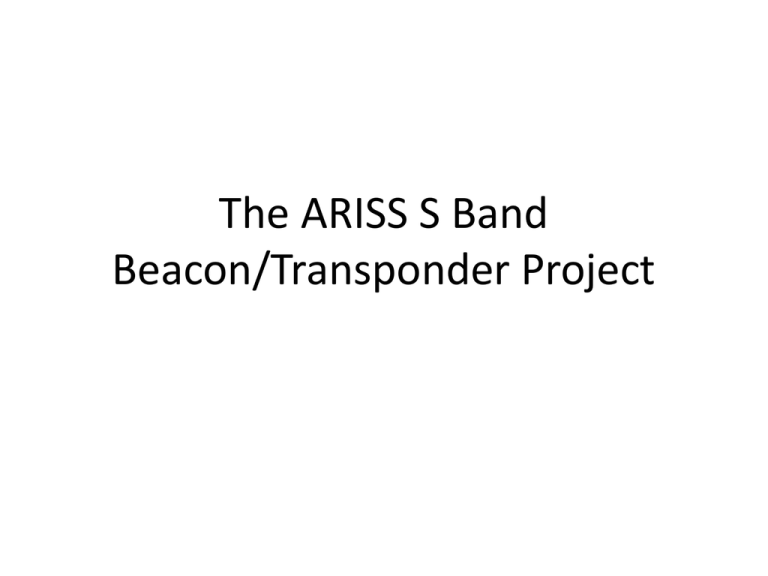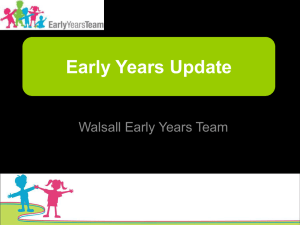File
advertisement

The ARISS S Band Beacon/Transponder Project S Band Beacon • There is a new S Band beacon and transponder being planned for the ISS-Ham station. This device is intended to serve as a beacon for the Ham TV Digital Ham TV system and also provide the capability of serving as an FM transponder. This unit will be capable of serving as an L Band to S band repeater as well as allowing re transmitting of audio from other sources onboard the ISS. Why Do we need this system? • We need to eventually replace the Ericsson system with a newer and more powerful transmitter. The Ericsson only puts out about 5 w power and that has made the ISS Ham school contacts more difficult and relegated to the more sophisticated ground stations. Current plans are to replace it with a Kenwood D710 mobile transceiver. This radio needs 13.8 VDC at about 12 amps. The only power supply capable of providing that power that is currently onboard ISS is in the Russian module and is not available in the Columbus module. Why Do we need this system? Cont. • The DATV system that was delivered to the ISS in August 2013 transmits on 2.4 GHz only when the DATV system is active. When it is running it is transmitting a digital signal which can only be received with a DVBS satellite receiver. That signal is difficult to track. • With the S Band beacon transmitting at the same time on a different antenna at 2.40015 GHz with a CW signal, a separate simple receiver can receive the signal and easily aid in verifying that the ground antenna systems is tracking the ISS. This will greatly enhance the probability of success of the DATV project. Why Do we need this system? Cont. • The S Band Beacon /Transponder presents the opportunity to add the capability to include the ability to transmit the audio signals from other sources. There are several sources envisioned for this transmission. The audio signal from another receiver such as the Ericsson transceiver, the VC-H1 SSTV system that is already onboard, or even an L Band receiver. Why Do we need this system? Cont. • The antennas that are on board the Columbus module are designed to be dual band. In other words they can be used to both transmit on S Band and receive on L Band simultaneously. We intend to take advantage of that feature by adding an L Band receiver module that will provide an audio signal to the S Band transmitter for re transmitting. • That will provide an FM transponder function. What are the tasks that are necessary to accomplish this? • The team to develop this system consists of the ARISS team and Kaiser Italia. The ARISS team consists of members (Volunteers) from AMSAT-NA and European ARISS members from Belgium, UK, Germany, AMSAT IT, AMSAT France and others yet to be determined. The Duplexer will be built by AMSAT NA by George Presley K4RSV. A proof of concept prototype has been built by George and tests indicate more than 40 dB separation is easily achieved. L Band Receiver The L Band receiver is being designed by David Bowman G0MRF. Here is the layout he has developed for the L Band receiver. Block diagram of the S Band Beacon/Transponder Components • The S Band beacon and transponder consists of several components. • The L/S Band Duplexer, The L Band receiver, and the Multifunction module. • The Multifunction module will be built by Kaiser Italia under contract to ESA. The Multufunction Module • The Multifunction module provides several services . • The S Band transmitter • The 13.6 VDC power supply, and the 6.0 VDC power supply. • The NTSC Video generator, the CW and telemetry encoder And the Audio processor and multi-Power outlets Modes of Operation • Current plans call for the system to have several modes of operation. • The default mode when powered up will be the CW Beacon mode. In that mode the system will continuously transmit a CW beacon that will include the station call sign and some telemetry such as temperature or pressure. • The Second mode will consist of an FM transponder mode. In this mode the system will send out an S band FM modulated signal with one of any of three audio sources selected by the ISS crew. Preliminary Specifications • Frequencies: S Band down 2.40015 GHz • L band up 1.2634 GHZ • UHF and VHF uplink depends on the receiver frequency setting. • Power output • CW Beacon mode 100mw. • FM Transponder mode 3 w . Overall Columbus Module Ham Station diagram What it means for the future • We will have a ham signal on S band coming down from the ISS. • This will provide a capability to conduct educational and ham activities on a mostly continuous basis. • The S Band Beacon/Transponder can be configured in several ways. VHF up S Band down, UHF up and S band down or L Band up and S Band down. This can be very exciting for both the Ham and the Educational community.







